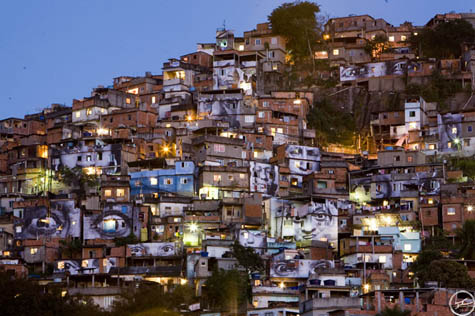 [Image: An installation of work by photographer JR on the walls of a Rio favela].
[Image: An installation of work by photographer JR on the walls of a Rio favela]."Undercover photographer" JR – who makes "photo galleries out of our streets" by exhibiting his work in public, as posters – has taken his exhibition strategy a step further. "What is at stake here," he writes, referring to this change in tactic, "is the assessment of the possibilities of intervention in different environments."
Amongst these environments are the favelas of Rio de Janeiro – however, here, these "possibilities of intervention" clearly include more opportunities for his work to gain greater exposure.
 [Image: Work by JR in Rio].
[Image: Work by JR in Rio].I have a variety of reactions to this.
My first thought upon seeing these photos was actually that it was quite an interesting visual transformation of the favela. The realization that the Cubist surfaces of a mountain subcity might be transformed, through fragmentary glimpses of representational art – these shard-like pieces of larger works that only add up from certain angles, as if in parallax – seems to be a discovery worth taking further.
However, at least two problems open up here: are you visually transforming the ghetto so that those who live in the city below no longer have to look up and see themselves surrounded by blight? They will see, instead, a hot new contemporary artist on display?
Or could you visually augment the favela in a way that positively impacts both the self-image of, and the quality of life for, the people living there while not erasing the presence of that ghetto from the visual awareness of the central city dwellers? Perhaps there could even be something that looks, I might say, just as bad from the outside, but that nonetheless benefits the people living within.
So the question is: who is this art really for?
Because there's actually a third player involved in all of this: the international art market, where these sorts of guerrilla exhibition strategies now increase one's chances of canonization (and coverage on blogs).
Less critically, though, I'm also curious here about the use of representational art.
So often we've seen the walls of favelas repainted with primary colors and such like, in an attempt to beautify or, to be more sinister about it, visually correct an otherwise offensive built environment. However, using the faceted hillsides of a favela as a kind of gemlike canvas for representational art actually seems to open up more interesting possibilities.
Could you paint, or glue a poster of, all 200,000+ frames from a new film onto the surfaces of distant buildings? And treat the city as a kind of cinematic installation, a cubist filmography in which walking around is a form of experiential editing? You could live inside a fight scene, or in the closing credits.
Or perhaps you could hike to the top of Buena Vista Park here in San Francisco and look out toward the high-rises of downtown – and see a photograph, installed anamorphically across the rooftops of different buildings, only correctly visible from this precise location (but what if that photo... is a Coke ad?).
Perhaps the future of Cubism is not in some painter's studio somewhere but in the ten million unexplored, minor surfaces of the city.
I'm reminded here of the (admittedly abstract) work of Felice Varini – and wondering what he might do, given a hillside with ten thousand surfaces all visible from multiple angles.
Finally, though, there are the eyes: in these images, you are being looked at in return. But who is meant to identify with this? Are these the eyes of the favela dwellers looking out upon a city they cannot access, as if to shame those more privileged residents? Or, as the poor wander home at night up steep streets, are these the eyes of the world looking down at them in judgmental scrutiny?
Again, though, there is a third class of people involved here. Perhaps these eyes aren't looking at the favela at all, and they aren't looking down at the city below.
They are looking out at the international art market, hoping for coverage in magazines and blogs, looking for their real, intended audience: the people who will see these photographs, at home, around the world. The city is merely their blank wall and host.
(Thanks to Adrian Giddings for the tip!)
No comments:
Post a Comment